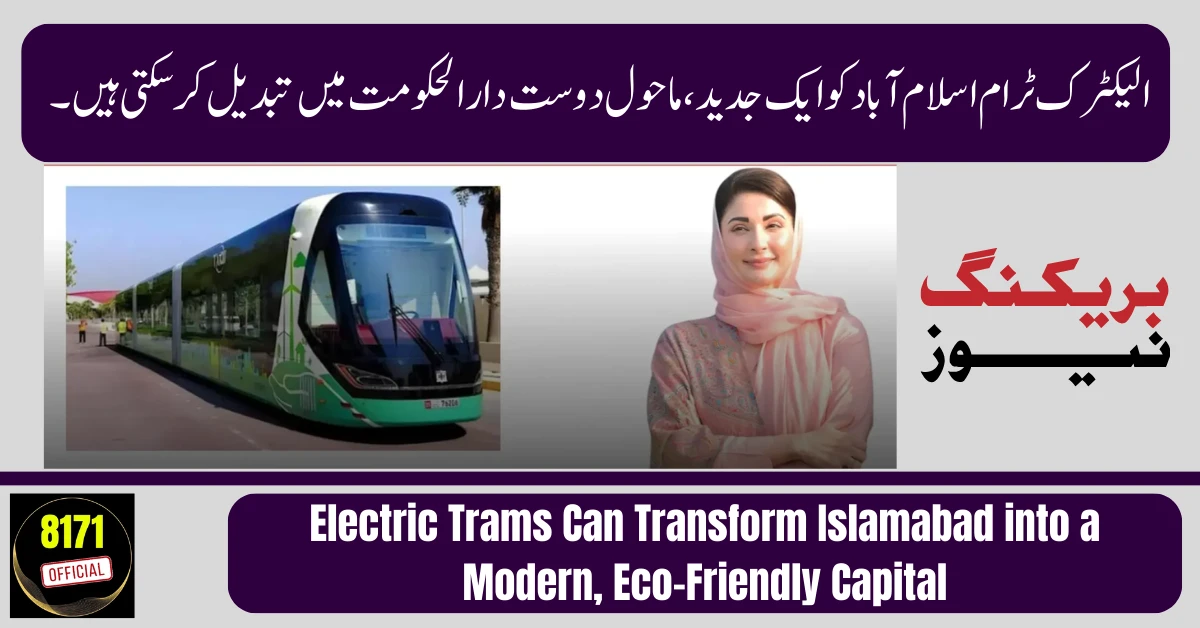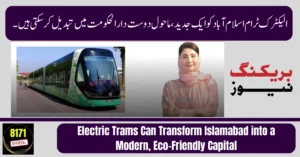Islamabad, Pakistan’s capital city, is known for its greenery, wide roads, and planned infrastructure. Yet like other major cities, it is facing growing challenges—traffic congestion, rising pollution, and urban expansion. To tackle these issues, the government is planning to introduce electric trams, a modern and eco-friendly transport system that has already been tested in Lahore.
If implemented successfully, electric trams will not just be a transport upgrade but a long-term investment in cleaner air, reduced congestion, and sustainable urban growth.
What Are Electric Trams?
Electric trams are rail-based vehicles powered by electricity rather than fossil fuels. They operate on fixed tracks laid along city roads or dedicated corridors and are powered through overhead wires or underground systems.
Key features of modern electric trams:
-
Capacity: Up to 250 passengers per tram.
-
Charging: Just 10 minutes of charging can power a 25 km journey.
-
Eco-friendly: No harmful emissions compared to diesel buses or cars.
-
Inclusive: Designed with level boarding for seniors, children, and people with disabilities.
This combination of sustainability, reliability, and accessibility makes trams one of the best solutions for modern urban transport.
Why Islamabad Needs Electric Trams
Islamabad is expanding rapidly, with increasing numbers of vehicles on the road. This growth has led to:
-
Traffic congestion during peak hours.
-
Air pollution contributing to health problems.
-
Long commuting times for workers and students.
Electric trams can directly address these problems by offering:
-
Cleaner transport: Powered by electricity instead of diesel.
-
Reduced traffic load: Hundreds of passengers moved in one trip.
-
Predictable schedules: Fixed tracks ensure timely services.
-
Less noise pollution: Quieter than buses and cars.
Environmental and Health Benefits
Electric trams are more than just a mode of travel—they are a health and environment solution:
-
Zero tailpipe emissions, reducing carbon footprint.
-
Cleaner air quality, lowering risks of respiratory diseases.
-
Less noise, making urban areas more peaceful.
-
When powered by renewable energy (solar/wind), trams become a 100% green solution.
This makes trams a crucial step in fighting climate change and urban pollution in Pakistan.
Global Success Stories
Electric trams have transformed cities worldwide. Examples include:
-
Melbourne, Australia – Largest tram network, carrying over 400,000 passengers daily.
-
Vienna, Austria – Runs entirely on electricity, cutting city emissions.
-
Amsterdam, Netherlands – Integrated with buses and bicycles for a complete eco-system.
These case studies prove that trams reduce congestion, improve urban life, and boost public transport usage.
Pakistan’s Progress with Electric Trams
-
Lahore became the first city in Pakistan to introduce electric trams, giving residents a cleaner, modern travel option.
-
Islamabad is now next in line, with plans to connect major residential sectors to business hubs.
If executed well, the Islamabad tram system could serve as a model for other Pakistani cities, making sustainable urban mobility a national reality.
Electric Trams vs Diesel Buses
| Feature | Electric Trams | Diesel Buses |
|---|---|---|
| Emissions | Zero | High (CO2, smoke) |
| Noise | Very low | Loud & polluting |
| Passenger Capacity | Up to 250 | 50–70 |
| Reliability | Fixed tracks, less affected by traffic | Delays due to congestion |
| Lifespan | 25+ years | 10–15 years |
| Cost per km | Lower (electric) | Higher (fuel, maintenance) |
This comparison shows why trams are a smarter long-term investment for cities like Islamabad.
Economic and Social Benefits
Electric trams don’t just improve transport—they transform city life:
-
Economic growth: Businesses near tram lines see more customers.
-
Job creation: From construction to operations, thousands of jobs are created.
-
Property value rise: Areas near tram stations often see better housing demand.
-
Inclusive mobility: Affordable fares make trams accessible to all income groups.
Challenges and Solutions
Like any big project, electric trams come with challenges:
-
High initial investment → Can be solved with public-private partnerships and international funding.
-
Integration with existing transport → Requires smart planning to connect with buses and metro routes.
-
Public adoption → Incentives, awareness campaigns, and smooth service will encourage people to shift from cars.
With proper strategy, the benefits will outweigh the costs significantly.
Future of Islamabad with Electric Trams
If implemented, electric trams could:
-
Reduce traffic jams across main highways.
-
Improve air quality by cutting down car emissions.
-
Promote sustainable urban planning with walkable communities near tram stations.
-
Make Islamabad a model eco-friendly capital in South Asia.
Conclusion
Electric trams have the power to transform Islamabad into a modern, eco-friendly, and people-centered city. With zero emissions, high passenger capacity, and long-term economic benefits, they are the future of sustainable transport.
As Lahore leads the way and Islamabad prepares to adopt the system, Pakistan is moving toward a cleaner, smarter, and healthier future. The success of this project will not only improve daily life for citizens but also set a benchmark for other cities to follow.













